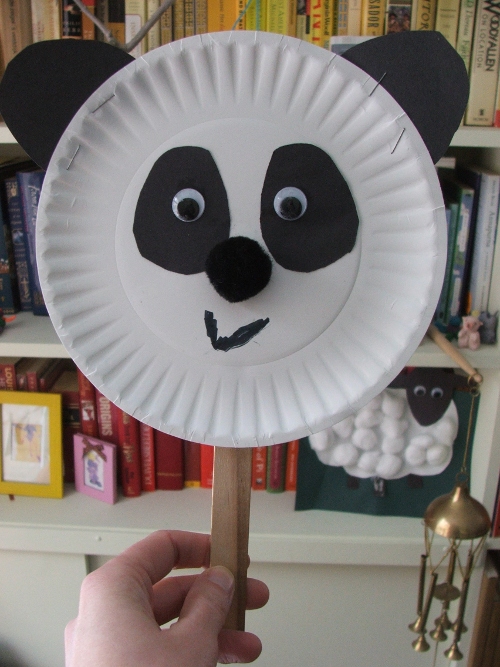I has just reread Lori’s Observational Drawing Lesson on the Camp Creek Blog when I looked up and spotted the perfect occasion for such drawing: Amie sitting at the table, waiting for her grandparents to appear on the troubled webcam, paper and pencil, and a panda bear mask she made in school. Okay, I thought, let’s practice seeing!
Lori advises to start with something simple, so the panda bear mask is perfect.
- The shapes are simple, yet varied, and well defined.
- There is only black and white, and no shades of gray (except in the details), so we can focus on the shapes.
- The alternating rings of black, white and black of the eyes would be a nice challenge for Amie. She often forgets which contour she is coloring in and often looks up to see she has colored in the whole image.
- There are only a few details (the staples, the shadows of the indentations around the rim of the plate, the pronounced grain of the wooden handle), and I thought it would be interesting to see if she would see them. But even without the details, the result would easily look like the original and be satisfying.
- It’s not too big and there won’t be too much coloring in, which she has little patience for. I give her only half a letter size piece of paper, to keep it manageable. The drawing could be done in 15 minutes.
To focus on shapes and later on on details, Lori says to use only a plain pencil. Amie has always had recourse to lots of colors, but for drawing she always chose just one of the bunch, so moving to a pencil was no problem for her. The only problem I have with plain pencils is that they don’t scan in very well, as the graphite reflects the scanner’s light.
Amie was so interested in the exercise that she wanted to do a second drawing right away, even though the grandparents had now appeared on the screen (they were happy to watch). Then I left everything on the dining table so the next day when we found ourselves there, she wanted to draw another one, and this morning at breakfast she drew the fourth. Here they are (click on image for larger):
I made sure we used our words, naming all the shapes and discussing their location respective to one another.
- We started with the circle of the face. I encouraged her to draw it big enough so there would be room for everything. In the first drawing she couldn’t get the circle quite right, but the next two were pretty close, while in the fourth she wasn’t paying much attention to the circularity.
- Then she added the handle underneath: the first time she didn’t get the thickness of it (and she added her own arm holding it), but when with the next drawing I pointed it out to her, she drew it as a long rectangle rounded at the bottom.
- Then she added the half-circles of the ears, on top but a bit off to the sides.
- Then she moved to the face itself. I suggested we draw the nose first, because it was nearly in the middle. She tried to get its fluffiness down by moderating the pressure on the pencil and going round and round in softer strokes.
- As for the mouth, she was more interested in its “thickness” than in its angular shape, and it had to be “smiley”. I pressed her to see and reproduce the shape, not the “feeling” of the expression, and she reluctantly did so in the first drawing but reverted to the smiley aspect in the other ones.
- The eyes were the most interesting: in the first three drawings she drew three circles, trying to size and position them right, which is very hard for her to do, motor-wise. Then she colored them in carefully. In the fourth drawing she decided there were four circles. I asked her why. She pointed to a tiny rim around the plastic of the googly eye. What a detail: I hadn’t spotted it myself! “That’s sort of whitish and blackish,” she said. “Gray?” I asked. “Yes.” She colored in that extra circle separately, but in black, so you can no longer see it.
- In the third drawing, when she was done, I asked if she had missed something, a detail? She didn’t spot any and I pointed out the staples, which she gladly added.
We worked on these drawings together, only I made sure she drew all the shapes, I just helped with the coloring in. I decided, as we were playing with shapes anyway, to add some writing of letters and numbers.
Unfortunately she discovered the eraser at the other end of the pencil. I tried gently to dissuade her from using it: she is already such a perfectionist! But more than often she erased my mistakes. “Your coloring is terrific, but mine is even better.” We’ll call that “confidence”…
Though the fourth drawing shows perhaps the most likeness, it was obvious from how seldom she looked at the original anymore that she was drawing her idea of the mask, not the mask itself. So it’s time to leave the mask and find something else!
This is a great daily exercise. It fills those 15 minutes when you wait for dinner to be set on the table or some computer to work, or while you’re having a snack or chatting.





fantastic – how wonderful that she saw that tiny detail!! :^)